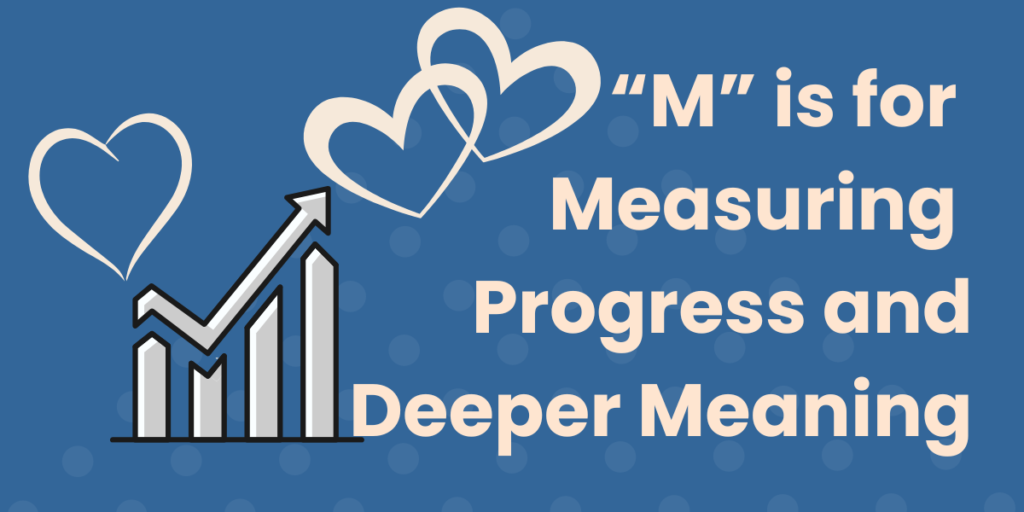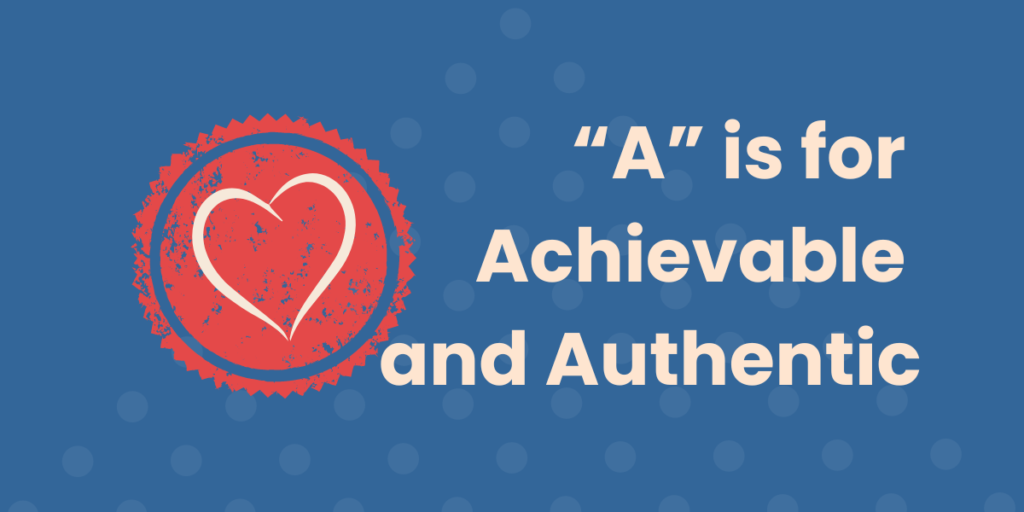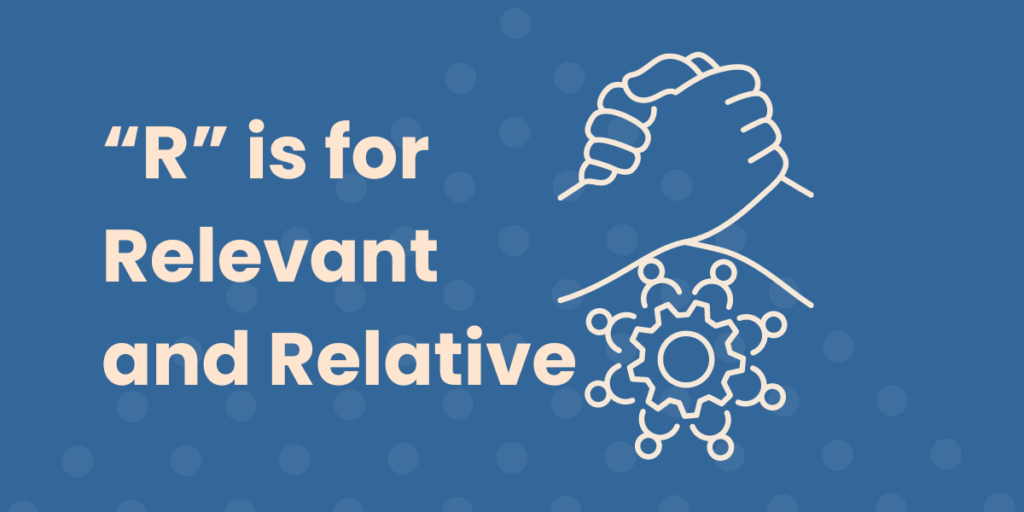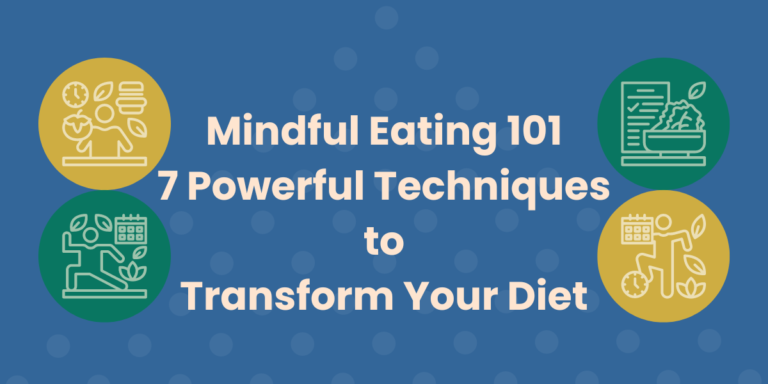SMART Nutrition Goals: Transform Your Diet in 2024
Let’s get real for a moment: We tried SMART nutrition goals. It didn’t work.
We’ve heard all the advice there is about setting goals.
- Don’t wait for the new year. Start NOW.
- Set SMART goals.
- Determine your OKR’s.
- Don’t make big, sweeping changes.
- Make big, sweeping changes.
- Focus on little habits you can change.
- Visualize, big picture, what you want to attract into your life.
- Feel gratitude as if you already achieved your vision.
Put your hands up if you’re confused! (Raising both my hands like I just don’t care. Oh! There’s the remote!)
Here’s the thing: these pieces of advice do work. They work individually or together. You can even mix and match them.
Just one problem: Why?
I don’t mean to sound like a toddler. However I want you to consider your why.
Rather than being bombarded with external influences, there must be an internal force which drives you.
Throughout this article, I’m going to guide you through your why.
By the end, I want you to have a solid nutrition goal that actually sticks, ebullient motivation, and a better understanding of your values.
That last part is the game-changing clincher!
Ready? Let’s begin.
What Are SMART Nutrition Goals?
George T. Doran introduced SMART goals in 1981 as a way to help companies develop.1 Here’s the trick: SMART goals only work if you have a purpose.
These companies knew their mission (what they did) and their vision (why they did it). They understood their values. They simply needed the final puzzle piece to propel them forward.
I want you to know your values. I want you to craft your goals and imbue them with your values. In essence, I want you to breathe life into your creative aspirations.
Definition of SMART goals (Specific, Measurable, Achievable, Relevant, Time-bound)
We know the definitions. If you don’t know them, then search for them. You don’t need me to regurgitate the same stuff you can find online.
Just remember this point: You have value because you have values.
Your goals need to reflect your values, otherwise they have no purpose to exist.
So let’s redefine SMART goals with values in mind.
- S – Simplicity:
- Life is chaotic. Simplify as much as possible.
- M – Meaning:
- If the goal means something, then you are in a constant state of growth and development. If the goal means nothing, then you are degenerating.
- A – Authenticity:
- Life is art. Living life is creative. See where you are. Appreciate how far you’ve come. Envision where you want to be. Then envision the beauty of your path. People forget that the path itself is your beautiful self-expression too.
- R – Relationships:
- Why is this goal worth your time? Why does it mean something to you? I often find that the bottom line never has a dollar sign, but a heart sign.
- T – Thoughtfulness:
- Thinking things through helps ensure commitment to your goals because you already thoroughly explored all possibilities.
These are personal values. Everyone has their own set of values.
Take some time to determine your own set of values; your own acronym.
If you’re more clever than me, then you can create a set of values which fits an acronym that spells out your core value.
So play around with it and explore.
Importance of applying SMART criteria to nutrition goals
As we begin to redesign our nutrition goals, applying SMART criteria takes on a new meaning.
Now our nutrition goals begin to resonate with us on a deeper level. Why?
Because we have begun to move the locus of motivation from an external source (I want to be healthier for my kids and grandkids) to an internal source (I want to be healthier for myself because being actively involved in my children’s and grand children’s lives makes me feel more alive!).
Let me give you an example.
Example of typical SMART goal vs. value-based SMART nutrition goal
Here is a typical SMART nutrition goal to reduce sugar intake:
- “I will reduce my daily added sugar intake to no more than 20 grams per day by limiting sugary snacks and beverages while replacing them with fruits or nuts. I will monitor my progress by reading nutrition labels and using a food tracking app. I will maintain this for 6 weeks to improve my energy levels and reduce the risk of chronic diseases.”
Here is the breakdown of this SMART goal:
- Specific: Reduce daily added sugar intake by limiting sugary snacks and beverages to no more than 20 grams per day.
- Measurable: Monitor sugar intake by reading nutrition labels and using a food tracking app.
- Achievable: Replace sugary snacks with healthier alternatives like fruits or nuts.
- Relevant: Improve energy levels and reduce the risk of chronic diseases related to excess sugar consumption.
- Time-Bound: Maintain this reduced sugar intake for 6 weeks.
This goal meets all the criteria of the typical SMART goal for someone who wants to improve their nutrition.
However, it seems sterile and unnatural; like a baby born in a petri dish.
Now let’s take a look at the same goal. This time, let’s see if we can bring it to life with important values. See if you notice the difference.
Value-based SMART goal:
- “I will simplify my diet by gradually reducing my daily added sugar intake to no more than 20 grams per day, focusing on natural, whole foods that resonate with my authentic self. By focusing on what makes me who I am, this change is meaningful because it supports my long-term health and energy. Therefore I can be more present and engaged in my relationships. I will approach this goal thoughtfully, choosing healthier alternatives with care, and reflecting on how these choices align with my values over the next 6 weeks.”
Did you feel the difference?
Now, you probably BELIEVE that this goal will come true.
There is a system to follow and substance to provide purpose.
Here is the breakdown of this value-based SMART goal:
- 1. Simplicity
- Component: “I will simplify my diet by gradually reducing my daily added sugar intake to no more than 20 grams per day.”
- Explanation: We start by focusing on making a simple, sustainable change.
- 2. Meaning
- Component: “This change is meaningful because it supports my long-term health and energy. Therefore I can be more present and engaged in my relationships.”
- Explanation: We begin to highlight the deeper purpose of improving your health and well-being, giving the change real significance.
- 3. Authenticity
- Component: “Focusing on natural, whole foods that resonate with my authentic self.”
- Explanation: The goal begins to emphasize making choices that align with your true self. This encourages a diet that feels genuine and aligned with who you are.
- 4. Relationships
- Component: “Allowing me to be more present and engaged in my relationships.”
- Explanation: The goal acknowledges that nourishing the body also nourishes valuable relationships through improved health and energy, underlining the importance of relationship to the self first to have mutually enhancing relationships with loved ones.
- 5. Thoughtfulness
- Component: “I will approach this goal thoughtfully, choosing healthier alternatives with care, and reflecting on how these choices align with my values over the next 6 weeks.”
- Explanation: The goal incorporates a mindful approach, encouraging you to make deliberate choices and regularly reflect on how your actions align with your values.
I hope you can see and feel the difference.
Now let’s get started with your own nutrition goals.

The “S” in SMART: Getting Specific and Simple with Your Nutrition Objectives
Let’s get specific and simple.
Why specificity and simplicity matters in goal setting
Life is chaotic and crazy and absolutely brilliant with endless possibilities. This makes life beautiful and confusing all at once!
So we need to be specific about what we want and make it simple and easy to follow. Less chance of being distracted from our chosen path.
More importantly, simplifying the goal can reveal deeper core values.
How to turn general nutrition goals into specific targets
Tell me about your chosen goal. (Obviously, you can’t talk at the screen. However imagine we are sitting across from each other and talking)
I’m curious, can you tell me more about:
- What do you love?
- What do you hate?
- What’s really bugging you right now?
- What makes you excited and inspired?
- What’s the first change you would make to FULLY live your life?
- What is missing in your life right now?
- What needs to be missing from your life from now on?
- What could we work on today that would make the biggest difference?
NOBODY makes a goal, much less a nutrition goal, just for its own sake.
If I could eat baklava and pizza without any adverse long-term health effects, then I would. However such a lifestyle leads to poor health which does not align with my values and vision of my future-self.
Reflect on the questions above.
You might be surprised to find that your nutrition goals have nothing to do with nutrition at all.
If that’s the case, then you can specifically identify what’s actually important to you and find a simple way to address it.
Examples of specific and simple nutrition goals
- Increase Fruit Consumption
- Goal: “I will add one piece of fresh fruit to my breakfast each morning for the next 30 days, choosing fruits that I genuinely enjoy and that align with my values of simplicity and health.”
- Practice Mindful Eating
- Goal: “For the next 2 weeks, I will eat one meal per day without distractions. I will focus on the flavors and textures of my food. Then I will reflect on how this practice nourishes my body and mind.”
- Limit Processed Snacks
- Goal: “I will replace one processed snack per day with a whole food alternative, like nuts or fresh veggies, for the next 3 weeks. I will choose something that requires no preparation and mobile to simplify my diet and make choices that feel more authentic and healthful.”

Measuring Progress, Deeper Meaning: The “M” in SMART Nutrition Planning
Let’s measure our progress and deepen our meaning.
Importance of quantifiable and meaningful goals
We need to make sure that we are progressing towards our goals.
After all, we have deadlines to meet.
There is one deadline that everyone must meet. The problem is that no one knows when they must meet their personal deadline.
So we might as well exercise the control we have in this life and create deadlines that are important to us along the way.
Tools and methods for tracking nutritional progress
Tell me more about:
- Why is this goal so important to you?
- Why did you choose this goal?
- What would be your desired outcome? Describe it to me.
- How will achieving this goal benefit you?
- What will happen when you are successful?
- How important is this goal to you personally?
- How will this change impact other areas of your life?
I find it really hard to directly ascertain the meaning of my goals. Ironically, it’s perfectly easy to measure where you are on the path to achievement. That’s very confusing.
However understanding the meaning of your goals takes a less direct approach.
Reflect on the questions above.
There are many ways to improve your nutrition. Why did you pick THIS way?
You chose this path because it meant something to you. Push yourself to find out why this path is the most meaningful to you.
Examples of measurable and meaningful nutrition objectives
- Increase Fruit Consumption
- Measurable: “I will track my daily fruit intake using a simple checklist on my phone. This way, I make sure to add one piece of fresh fruit to my breakfast each morning.”
- Meaningful: “I will track my daily fruit intake with a checklist on my phone because I want to nourish my body in a way that’s natural and aligns with my commitment to a healthier and simpler lifestyle.”
- Practice Mindful Eating
- Measurable: “I will set aside 15 minutes each day to eat one meal without distractions, using a timer to ensure I’m fully present during that time.”
- Meaningful: “I want to set aside 15 minutes each day to eat one meal without distractions because it helps me appreciate my food more deeply and promotes a sense of mindfulness to enhance my overall well-being.”
- Limit Processed Snacks
- Measurable: “I will document my snack choices each day in a food journal, noting each time I replace a processed snack with a whole food alternative.”
- Meaningful: “Limiting processed snacks is meaningful because it supports my desire for simplicity and authenticity in my diet, making choices that truly reflect my values. Therefore I will use my journal to simultaneously measure progress and as a tool of reflection”

Keeping It Real: Setting Achievable and Authentic Nutrition Goals
The best way to achieve something is to have already achieved it.
How do you achieve something you’ve never achieved before?
By making sure it is authentic to you.
As you read these words, you are already the culmination of a lifetime of achievement.
You are who you are because of your values.
You made mistakes and good takes. It’s all determined by whether or not you abide by your value system. Through this process, you’ve learned to develop them into the richness of you.
Balancing ambition with realism in goal setting
As a man that enjoys pie, I am amazed by the utter lack of pie in the sky.
Maybe I’m not using my imagination to see the buffet in the clouds. However I would like to actually eat the pie here on Earth.
This is the difference between ambition and realism.
We must balance imagination and dreams with actionable and concrete steps.
So how do we do that?
Factors to consider when determining achievability and authenticity
Consider these questions:
- How important is this goal to you personally?
- What’s really important to you in life?
- If you achieve this goal, will it set you up for achieving other goals in life?
- Tell me how this goal aligns with your values? With your life vision?
- Are your goals truly YOUR goals? Or do they feel like something you think you should have or do? If so, where does that sense come from?
- What do you sense when you think about achieving your goal? Contentment? Fulfillment? Excitement? If not, reconsider where this goal comes from.
Again, finding authenticity is never a direct process. Take time to explore some of these questions.
The whole point of nutrition goals is growth and development. This is the process.
Strategies for breaking down larger goals into manageable steps
Sometimes a goal does not feel authentic because it is too large.
Maybe certain components of the goal are authentic to you.
It’s up to you to deconstruct that goal, find the parts that are important to you, then reconstruct these important pieces in a way you find genuine.
Here’s a step-by-step process to guide you:
- Take your goals and break them down to the individual parts (S.M.A.R.T.)
- Acknowledge the challenge you are facing.
- Appreciate the emotions that arise.
- Find where these feelings are coming from.
- Do they resonate within your heart?
- Does it bring up pain or joy?
- Explore where that comes from.
- Notices which pieces are misaligned.
- Can they be adjusted or replaced?
- Reconstruct your goal.
- It may need to be simplified.

The “R” Factor: Ensuring Your Nutrition Goals Are Relevant And Relative
In my opinion, we pursue goals for the relationships we crave.
We desire a relationship to the goal, to others, and to the self. Every level of relationship matters.
So how can we make your goal relevant and relative?
Aligning nutrition goals with overall health and lifestyle objectives
Remember: Any goal you desire is born from your core values.
Values have a multitude of ways to find self expression.
Nutrition is merely one way a value seeks fulfillment in this world.
Therefore, your nutrition goal may not be a nutrition goal; but a goal for greater fulfillment.
Since we are social creatures (even the most introverted amongst us), greater fulfillment is often achieved through relationships with self and others.
So how do you align nutrition goals with your overall health and lifestyle objectives?
By discovering the hidden value underneath the goal first.
Is it acceptance or belonging? Autonomy or freedom? Creativity and imagination? Family and gratitude? Truthfulness and understanding?
Your desire to achieve your goal is a gift of opportunity to deepen your relationship with yourself.
Take full advantage of this opportunity by exploring what value is trying to make itself known to you through the expression of better nutrition.
Personalizing goals to individual needs and preferences
We finally discovered your expressive value (or values). What now?
Now we connect the dots.
How does our value connect to nutrition? Why didn’t it connect to juicy burgers and french fries instead? Or why didn’t it connect to something completely irrelevant like saving the environment or volunteering in your community?
To personalize your goal, you need to understand the relationship of the goal with the value.
This establishes two-way communication so that they feed each other vital information throughout the path towards achievement.
This is why you might start on a goal and then lose interest. You start on a goal for better nutrition because you value family time, only to realize that family time is also served by consistent outings to the ice cream parlor.
Eventually the waters get muddy and the communication gets frayed because the pristine communication lines were manipulated to serve the same purpose but with a poor process.
So how do you protect the integrity of that communication?
By knowing what is relevant and what is not.
Examples of relevant vs. irrelevant nutrition goals
- Increase Fruit Consumption
- Relevant Goal: “I will add one piece of fresh fruit to my breakfast each morning, choosing fruits that my family and I enjoy. This will invite everyone to improve our health together if they want to join, fostering a shared commitment to wellness.”
- Why Relevant: This goal is relevant because it not only supports your personal health but also strengthens your relationships by inviting those close to you in a shared healthy habit.
- Irrelevant Goal: “I will add an exotic fruit to my breakfast each morning, regardless of whether my family likes it, because it’s trendy.”
- Why Irrelevant: This goal might benefit you nutritionally, but it doesn’t align with your values of simplicity or relationships. This focuses on external trends rather than fostering authenticity, connection, or shared enjoyment.
- Relevant Goal: “I will add one piece of fresh fruit to my breakfast each morning, choosing fruits that my family and I enjoy. This will invite everyone to improve our health together if they want to join, fostering a shared commitment to wellness.”
- Practice Mindful Eating
- Relevant Goal: “I will practice mindful eating during family dinners, setting aside time to enjoy the meal and each other’s company without distractions.”
- Why Relevant: This goal is relevant because it enhances both your personal mindfulness and your relationships by creating a space for genuine connection during meals.
- Irrelevant Goal: “I will practice mindful eating only when I’m eating alone..”
- Why Irrelevant: While beneficial for personal mindfulness, you miss out on the opportunity to enhance relationships.
- Relevant Goal: “I will practice mindful eating during family dinners, setting aside time to enjoy the meal and each other’s company without distractions.”
- Limit Processed Snacks
- Relevant Goal: “I will replace one processed snack per day with a healthier alternative and invite my family to join me in this effort, fostering a collective move towards better nutrition.”
- Why Relevant: This goal is relevant as it not only improves your diet but also invites others into the journey, supporting shared health goals and strengthening your relationships.
- Irrelevant Goal: “I will limit processed snacks by keeping them hidden from my family so I can make healthier choices without their influence.”
- Why Irrelevant: This goal might improve your diet, but this method isolates you from others. This builds walls instead of building strong, supportive relationships.
- Relevant Goal: “I will replace one processed snack per day with a healthier alternative and invite my family to join me in this effort, fostering a collective move towards better nutrition.”

Time-Bound and Thoughtful Targets: The Final Piece of SMART Nutrition Goals
Here is where we control our lives.
What have we done so far?
- We chose a goal.
- We dug out the value.
- Reassessed the goal’s significance to our lives.
- Explored various possibilities to achieve that goal.
- Verified authenticity.
- Established and protected two-way communication between our goals and values.
- We determined its relevance and effect on loved ones.
Now we must set our deadline.
Importance of deadlines in goal achievement
Life’s biggest irony is that we don’t know our ultimate deadline.
The second irony is that we don’t fear it until it seems inevitable. So we lose the motivation to live this life fully.
However we can look forward to the deadlines that we create.
We want to shed the person we once were in order to step into a greater being in this life.
These milestones promote goal achievement; but more importantly, they promote greater alignment with your values.
Setting short-term and long-term nutrition milestones
This is where I find value in objectives and key results (aka: OKR).
Objectives are essentially goals. Key results are small milestones along the path.
Follow the milestones on your path, and you will arrive at your objective.
Stray away from the path, and you will have to consult your internal guidance system to correct your course.
Here are a few examples of creating short-term and long-term milestones with OKR’s:
- Increase Fruit Consumption
- Objective: Cultivate a healthier breakfast routine that includes more fruits, shared with my family, within the next 30 days.
- Key Results:
- Add one piece of fresh fruit to my breakfast each morning for 30 days.
- Encourage at least one family member to join me in this habit by the end of week 2.
- Track fruit consumption daily using a simple checklist or app, and reflect weekly on how this habit is positively impacting my family’s health and well-being.
- Practice Mindful Eating
- Objective: Develop a mindful eating practice during shared meals to enhance both personal and family well-being over the next 4 weeks.
- Key Results:
- Practice mindful eating during one meal per day, free from distractions, for the next 4 weeks.
- Invite at least one family member in this practice during dinner time by the end of week 2.
- Set aside 15 minutes after each meal to reflect on how this mindful eating practice is enhancing connection and overall satisfaction with the meal.
- Limit Processed Snacks
- Objective: Reduce processed snacks and replace them with whole food alternatives, fostering a collective commitment to healthier eating over the next 6 weeks.
- Key Results:
- Replace one processed snack per day with a whole food alternative for the next 6 weeks.
- Let my family know why I chose to take this action and invite them to participate by highlighting stronger bonds.
- Track snack choices in a food journal. Note improvements in energy levels and mood. Reflect on these improvements weekly.
Strategies for creating a timeline for your nutrition goals
I am a visual person.
So I use calendars, to-do lists, personal organizers, and kanban boards.
There are a multitude of tools at your disposal.
Keep your objectives achievable within 3 months. Your key results can be achieved every month.
Use a visual aid to outline your goals and the steps along your path.
This will be your roadmap to success!
Overcoming Obstacles: Staying on Track with Your SMART Goals
It’s hard enough to craft a goal tailored just for you.
However, do you remember part of what makes this life so beautiful and wonderful?
Yup. You’re still sitting in this milieu of chaos and endless possibilities.
What’s worse, you actually know who you are and what you stand for.
So Murphy’s Law will be your best frenemy really fast!
It’s up to you to stay on track. So how do we fortify your efforts?
Remember what I told you to remember: You have value because you have values.
Also, you have vices because you have virtues. One does not exist without the other in hand.
Let me explain.
Common challenges in nutrition goal achievement
People have nutrition goals for various reasons. Ironically, poor habits have a way of masquerading in good intentions.
Let’s have a look at the top 3 challenges:
1. Lack of planning
People want to be healthy and energetic to have meaningful relationships with their family; but doggone it if they love having deep conversation by going out for ice cream every evening after dinner!
Sure, the nightly ice cream isn’t necessarily good for you. However the family has a good time smiling and laughing. Don’t you want everyone to be happy and share quality time together? Don’t you want to share in that joy?
Who can say no?
You can see how thoughts twist and go sideways. What happens if you try to fight it directly? It fuels the fire. Suddenly you’re going out for ice cream (or whatever vice) twice as often.
So what do you do? Plan it out.
“You know, we have ice cream on the weekends. Let’s add a little variety tonight by watching a movie and trying a healthy popcorn brand instead.”
If you go into battle, then you will lose.
That is why thoughts for poor habits never take a direct approach. They explain how the poor habits align with your values. Then you’re convinced through suggestions.
Take the indirect approach of experimentation and discovery.
Begin to tell your thoughts, “I appreciate your suggestions. Those seem like good options. Let’s consider other options that might better serve my health.”
In this way, your thoughts become your ally.
2. Emotional eating
Question: What do your ex, your mother-in-law, and Monday morning all have in common?
Answer: Your favorite comfort food to forget your problems.
We even have grades of comfort foods depending on the severity of the problem. In my opinion, a Level 10 problem demands cheesecake!
So what do you do?
Technique #1: Pause, and take a breath.
This is one of seven techniques I outlined. However I find this technique the most powerful.
If you want your comfort food du jour, go get it; then pause, and take a breath before you tucker in.
Afterwards, journal about your emotions.
- What came up?
- What caused them to come up?
- Were there any triggers?
- Tell me more about them.
- Can we trace that back to the first time you felt this way?
As you journal, you simultaneously process emotions and subconsciously realize that there are healthier ways than scraping the bottom of a pint of rocky road.
3. Eating quickly
Grade school has trained me to eat my lunch quickly, play fast outside, and hurry back inside to start class again. Somehow we squeezed all that into half an hour.
Highschool continued this training with stricter time constraints. I only got 25 minutes for lunch.
I had hours of time for lunch in college, but taking more than a mere 15 minutes felt unnatural to me.
Then the half hour limit comes back when we join the workforce.
At an early age, we have been indoctrinated to eat quickly and get back to work.
So how do we undo this habit and find a new balance?
By becoming aware of it.
We cannot simply dispense with quick eating because it is a necessary skill for those of us that keep a schedule (basically everyone).
However we can learn to become aware of the skill we developed, become aware of what circumstances are best suited for this skill, and become aware of other skills to deploy for other scenarios.
For example, eating quickly is important in the context of a lunch break, running to soccer practice with your kids, or grabbing a quick bite before continuing your road trip.
However, taking time to savor flavors, learning to appreciate how the wonderful aromas make your mouth water in anticipation, and enjoying good food with good company is another skill.
Eating quickly is a problem of mindful eating.
- Pause and breathe before every bite.
- Engage your senses.
- Minimize distractions.
- Slow down to savor.
- Listen to your body’s hunger and fullness cues.
- Choose nourishment over restriction.
- Express gratitude.
Adjusting goals as needed without losing momentum
Remember: The goal carries the value you provide it.
Motivation can eb and flow, but your value will always be there.
If the goal no longer seems important, then consult your values. Does this goal still help you align with your values?
If yes, then you’re in a slump. If not, then reassess and adjust the goal or let it go.
Conclusion:
Wow! That was A LOT!
Remember, setting SMART nutrition goals isn’t just about ticking boxes – it’s about creating a roadmap to the healthier, happier you that allows you to live your life according to your values.
So, grab a pen, use the examples above, and start crafting your first value-based SMART nutrition goal.
If you need help, book a consultation to see if we can work with each other.
Take that exciting first step towards your transformation.
Your future self will thank you!
References
- Doran, G. T. (1981). “There’s a S.M.A.R.T. way to write management’s goals and objectives” (PDF). Management Review. 70 (11): 35–36.






